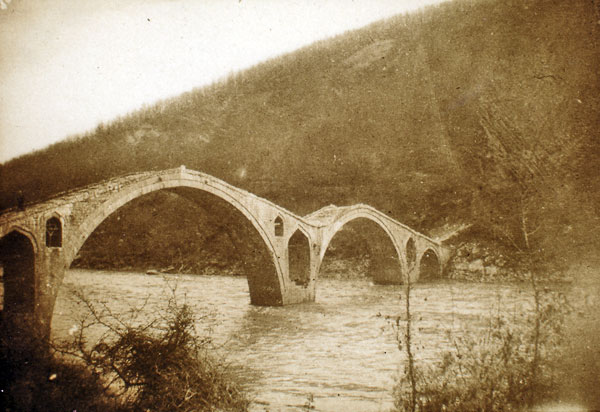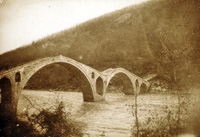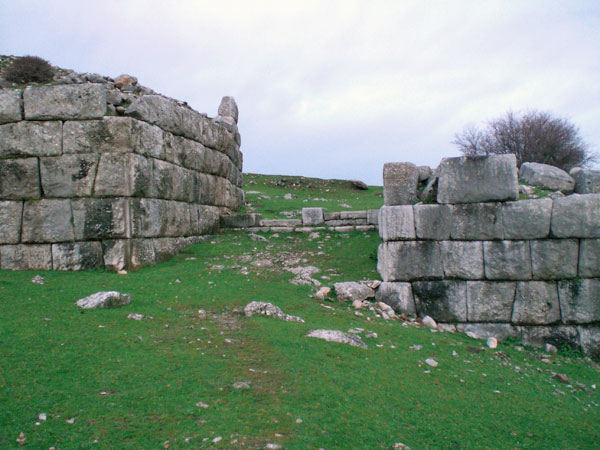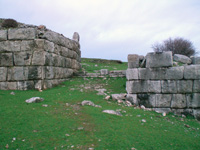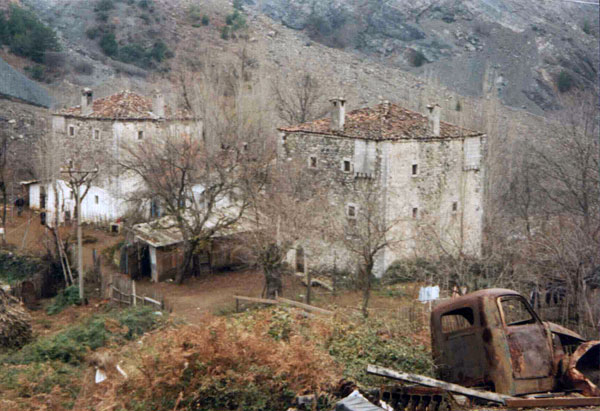| | Robert Elsie | AL Art | AL History | AL Language | AL Literature | AL Photography | Contact | |
Robert Elsie
Texts and Documents of Albanian History
BACK | AL History
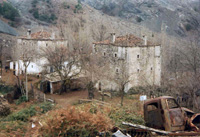
Houses near Orosh in Mirdita
(Photo: Robert Elsie, November 2002)
1866
Emile Wiet
The Diocese of Lezha and MirditaEmile Wiet was a French diplomat who served as consul in Shkodra in the 1860s. He is the author of several articles on Albania, published in French journals of the period. The following essay is a description of the Catholic diocese of Lezha and Mirdita in northern Albania in the mid-nineteenth century.
1. Topography, ethnography and statistics
Size and boundaries: The Diocese of Alessio [Lezha], that is 52 leagues in length and 15 leagues in width, borders to the south and east on the Diocese of Durazzo [Durrës], to the north on that of Sappa, to the northeast on that of Prisrend [Prizren] and to the west on that of Scutari [Shkodra] and the Adriatic Sea. Its natural borders are: to the south and east the Matia [Mat] River and its two tributaries, the Lesser and Greater Fandi [Fan], down to the Prei-Sriset [Përroi i Sërrishtës] that divide it from Durrës; then the chain of mountains called on maps Ibelea [Iballja] stretching to the bridge of Spas (Vau Spas), that forms the border to the northeast with Prizren; to the north, taking Spas as a point of departure, the Ghjoska [Goska] River forms the border with Sappa; and finally to the west, the highway of Ciaffa-Malit [Qafa e Malit], then Krabi [Krrab] and Bieseka [Bjeshka] to the Glomsichja [Gomsiqja] River form the border to Shkodra.
Mountains: The chain of mountains crossing the Diocese of Lezha can be considered as an extension of the Sharr (Scardus) Mountains. Its highest peaks are called the Veglia [Vela] that rises above Calmetti [Kallmet] and forms the ridge of Freglina [Fregna] to the east, the Ugrii [Ungrej] and the Calori [Kalur] down to the Fan; to the north that of Cresta [Maja e Kreshtës] that dominates the Zadrima region and stretches to the Ghadri [Gjadri] torrent; to the southeast, this chain divides into two branches that form the valley between Criesesi [Kryezi?] and Bulgari; to the south it is called Molungo [Molungu], on the other side of which are the villages of Grücca [Gryka], Manatia [Manatia], Trinsci, Spidani [Spiten], Soimendi [Zejmen] and Pedana [Bërzana]. The Bieseka-Ses, around which, starting from Corsopullo [Korthpula], are the parishes of Castanietti [Kashnjet], St. Georgio [Shën-Gjergj], Cacinari [Kaçinar], the towns of Gegiani [Gjegjan], Gojoni [Gojan] and Scosa [Shkoza], and part of Qafa e Malit. This mountain is linked to that of Krrab in the Diocese of Sappa. The Fan, the highest peak of which is the Monella [Munella] is called Bosci [Maja e Boshit] and Koravi [Korab] to the northeast, both chains extending towards the Vizier’s Bridge on the Drin; to the south and southeast, those of Ruena, Kumla [Kumbulla], Zeppe [Zeba] and Mali Sentit [Mali i Shenjtë] that dissipate into the Nderfantina region.
The Vizier’s Bridge on the Drin
(Photo: Franz Nopcsa, 1905)The Munella has two distinguishing characteristics: firstly, on this peak there is a long plain covered in snow all year round, at the eastern edge of which is a sort of pit that swarms with poisonous snakes; secondly, at certain moments, more or less close to one another, a spring called Vigani gushes out of the heart of the mountain, crosses the village of Kimessa [Kimza] and, without rain or other atmospheric reason, tumbles in a loud torrent down onto the plain, taking with it boulders and trees, etc. The villagers are terrified of it and traditional superstitions associate it with a dragon living within Munella that they call Coliedra [kulshedra]. The phenomenon occurs normally in April.
Rivers: The main rivers are the Drin and the Mat. The former does not originate in the diocese but traverses it entirely and flows into the Adriatic Sea beyond Lezha. The latter emerges from the Cidena [Çidhna] region and, having been joined by the Greater and Lesser Fan, it flows along the demarcation line between the Diocese of Lezha and the Diocese of Durrës and also empties into the Adriatic. The major tributaries, aside from the Greater and Lesser Fan that have the same name although different origins, are the Ghioska [Goska], the Gjadri and the Gomsiqja.
The Greater Fan comes down from Mount Krrab and is joined by nine tributaries. The Lesser Fan comes from Mount Munella and has three tributaries. The Goska comes from Rosci [Maja e Roshit] and flows into the Drin slightly below Vau Spas towards Prizren. The Gjadri comes from Mount Munella, joins the Vorna and flows into the Drin near the village of the same name in Zadrima. The Gomsiqja comes from Bieseka-Ses and also flows into the Drin slightly above Vau Deja or Zadegne [Zadeja].
Lakes and marshes: The diocese does not have any lakes. The largest marshes are: that of San Martino above Triuschi, that of Knet-colcedres south of the Fransiscan hospice in Lezha; that of Knali at the mouth of the Drin near the port of Saint John of Medua [Shëngjin]; that of Mriva beyond the Drin; and finally the one stretching to the southwest of Baldrani [Balldren] and Cacarichi [Kakarriq] that infects the air and makes it unhealthy. In the latter marsh, there are little islands covered in trees that attach themselves to one bank and then to another.
Forests: Almost all the mountains of the diocese are covered in forests. The richest forests are those of Fan, Orosh and Munella. There are also fine forests on the plain of Berdloja, between the Drin and the Mat rivers. Pines, sessile oaks, firs, oaks, beeches, elms, junipers, lindens and poplars are the trees one encounters most frequently. Plane trees are less numerous and cypresses produce only withered trees.
Population: The total population of the diocese is 22,340, living in 2,734 houses. The population is divided into 5,050 Muslims in 630 houses; 17,279 Catholics in 2,104 houses; and 12,256 Mirditors in 1,450 houses. The Muslims live in Lezha and Mal-isi [Mal i Zi i Dukagjinit]. There are no mixed villages in the diocese. The Catholics can be divided into banners to which they belong as mountain Catholics and flatland Catholics. The following chapter will provide details as to their strength and composition. The inhabitants of the diocese are Albanian and speak only Albanian.
2. Religious communities, public education, and political, administrative and legal institutions
The Catholic Church: The diocese is headed by the Bishop of Lezha who resides in Kallmet. He is suffragan to the Archbishop of Durrës, but this subordination is restricted by the direct and absolute activities of the Propaganda Fide in Rome. The laws governing the clergy are the canons of the Church and special instructions issued for the missions.
The clergy is national and secular, except for the so-called Franciscan Mission of Epirus that succeeded the former Provincia Albana. The diocese has a sufficient number of churches. Most of the buildings are badly constructed and consequently in need of frequent repair. The most solid buildings are those of Kakarriq and Balldren, as well as the Franciscan hospice in Lezha. On Holy Mountain [Mal i Shenjtë] overlooking Orosh, there is a large church dedicated to Saint John the Baptist, given to the Franciscans by Pope Clement VIII. All the churches have bells that may be rung freely, with the exception of the Church of Saint Nicholas at the market in Lezha, and the Franciscan hospice in the same town, although situated on the other side of the Drin. This latter church seems to date from the year 1240, and the two chapels of Kakarriq and Balldren from the 15th century, the age of Venetian rule.
According to the Franciscan historian Wadingo [Lucas Wadding], from earliest times, the Franciscan province of Albania had about thirty hospices and convents throughout all the dioceses of Albania. Today, there remain only the hospice of Caporadoni in Sebaste [Sebasta] in the Diocese of Durrës; that of Trosciani [Troshan] in the Diocese of Sappa; and finally those of Rbien [Rubik] and Lezha in this diocese. The latter is considered to be the mother house. Until 1831, the hospices constituted the religious province. They were served by national priests, but with a foreign provincial who was obliged to visit regularly and then return to his post. The travel expenditures were more than he received and for this reason a papal brief abolished the province at that time and instituted the observer mission that has, however, still not been legally established.
The Diocese of Lezha has twenty three parishes, of which twelve are in Mirdita, being the region above Mount Kreshta, also simply known as the Mountain, and eleven in the region below Mount Kreshta.
In addition to the parish churches, there are nine chapels served by parish priests who go there from time to time during the year.
There are twelve parishes for the region above Mount Kreshta, serving forty-nine settlements (1,450 houses and 12,256 inhabitants). For the region below Mount Kreshta, there are eleven parishes serving fourteen settlements (654 houses and 5,023 inhabitants).
Islam: There are several mosques in the Diocese of Lezha, two of which in the town: one was formerly the Church of Saint George; a third one near the parish of Gryka and three much smaller ones in Mali i Zi and in the other Muslim villages behind the Fan mountains.
Public Education: Of the 17,279 Catholics in the diocese, only about fifty know how to read, and only just. Ten know how to sign their names. Education has been severely neglected. That is, there are neither schools nor persons willing to teach young people about the obligations of the Catholic Church and society. If one compares this state of ignorance to that of the Orthodox in the other provinces of the Empire, one is not surprised to see that the latter, in general, manage to rise above their original state and attain a certain level of prosperity. Up to the age of eleven, young people attend schools that even the poorest Greek villages in the Pindus Mountains maintain, financed by the communities in question. The Muslims of the Diocese of Lezha send their children to the hodja or to a simple muezzin serving the mosque, who teaches them to read and instructs them in their religion.
Political, administrative and legal institutions: No diocese is so lacking in political institutions as Lezha. Most of the diocese is subject to the Pashalik of Shkodra, though two parishes, Bërzana and Zejmen, depend both on the Governor of Monastir [Bitola] and the commander of Tirana. The latter figure only exercises control by means of his zaptiehs [police] charged with collecting taxes, and has never set foot in the two parishes, that are separated from the rest of the district by the Mat River, over which there is no bridge. The part subject to the Governor of Shkodra is subdivided into several mudurliks. The mudir of Daici [Dajç] in Zadrima has nine-tenths of the parish of Kallmet; the mudir of Lezha has the rest of the parish, and those of Lezha, Vela, Bulgari, Criesesi, Gryka and Merchigne [Mërqia]. The governor general is the direct head of the parishes of Balldren and Kakarriq, situated on the other side of the Drin.
The rest of the Mirdita villages enjoy complete autonomy in their internal administration, at the head of which is a Catholic chief who holds the title of a pasha and the rank of a brigadier, given to him by the Porte at the request of Marshal Duc de Malakoff at the end of the Crimean War.
Each mudir has a kaza counsel and a kadi that only decide on matters of lesser importance. Important matters are decided upon by the government in Shkodra.
There are prisons, in a terrible state, at Lezha and Dairi. The gendarmerie, with its insufficient numbers, is unable to maintain public order.
The Fortress of Lezha
(Photo: Robert Elsie, March 2008)Defence: The only fortress in the diocese is that of Lezha, that rises to about 183 metres above the town and may be considered as the key to the plain of the Drin. Today, there is no garrison within its vast walls and there is nothing there but a pile of ruins on which have been mounted several canons that no longer function.
The Diocese of Lezha and that of Sappa form somewhat of an island, separated from the rest of the country. They are bordered on the one side by the Drin and on the other by the two Fan rivers, and there are mountains and gorges that give it a naturally fortified position. Banditry has made both roads crossing this territory unsafe.
Armed forces: There are no regular armed forces in the diocese. Those that the government can muster in time of need amount, for the Muslims, to 1,200 rifles (two rifles per house), 2,400 pistols and 60 sabres. The Catholics, for their part, have 4,000 rifles, 8,000 pistols and 200 sabres.
Taxes: To determine the amount and types of taxes and revenue, one must remember the political division of the diocese. The five banners of Mirdita used to pay the sultan only 10 para per house as a defence tax. This tax was progressively raised to 100 para, but it has not been collected for several years, probably in view of services rendered by the men of Mirdita in the recent expedition against Montenegro [1852] and in the last war against Russia [1853-1856]. It is custom for the Pasha of Shkodra to give the chief of Mirdita ten loads of maize as a gift every year. He keeps half and distributes the rest among the various chiefs and their deputies of the other banners. Much vexing pressure is exerted upon the villagers of Kallmet, Toshan and Blinisht etc. to supply this maize. Pedana and Soimendi pay taxes in line with the Tanzimat provisions since these two villages belong to the Pashalik of Monastir.
The five banners of Lezha pay four and a half piastres defence tax annually per house. The villages of Mërqia, Gryka, Manatia, Triusci and Spiten are also subject to the tithe, and the villages of Vela, Kriesesi and Bulgari are exempt from it in view of their obligations to serve in the army as bashi-bouzouks. Kallmet, or rather its 70 houses, pay not only the tithe, but a tax called pegh or mactoum that amounts to 2,500 piastres a year, plus 60 para for each bovine. This tax is only 10 para in the rest of the province. Balldren and Kakarriq pay the tithe and communal taxes raised by Shkodra.
The town of Lezha pays the following taxes each year: 15,000 piastres as an excise tax on spirits; 2,000 for crossing the Drin (20 para per person); 4,000 for taking a laden horse through town, being 20 para for each 100 oka of baggage. Another fee is levied to repair the roads.
Public hygiene: There is a health office in Lezha for ships arriving in Saint John of Medua where the health official and his deputy reside.
In the mountains, the most lethal disease is a putrid fever called sujutra or moria. The latter word was given to it after the return of the Albanians from the war in the Morea [1714-1718]. Intermittent fevers are also very frequent, in particular in the region below Mount Kreshta, except in the parishes of Vela, Criesesi and Bulgari. Gryka, Kakarriq, Balldren and Lezha are the most affected because they are situated near the marshes. In the mountains, deaths are frequent because of the lack of precautions taken by the population against epidemics. There are no physicians in the diocese so the inhabitants are forced to care for themselves. Occasionally, the call on the priests for help, who generally have some basic medical knowledge, but they only do so at the last minute, and they rarely carry out the prescribed treatment. There are, however, people who know how to treat wounds caused by firearms.
3. Organisation in Mirdita
We have seen that the whole population of Mirdita was 12,256, occupying 1,450 houses. They live in the mountains that, seen from Kallmet, stretch to Vau Spas, that is to say to the Vizier’s Bridge near Prizren. A small part of Mirdita is included in the Diocese of Sappa. These are the parishes of Muella-Spacit [Mnella] and Vigu [Vig]. In addition to this population, there are 450 families from Mirdita living as colonists near Gjakova.
Mirdita is divided into five banners, being Orosh (123 houses), Fan (290 houses), Spacci [Spaç] (406 houses), Cusneni [Kuzhnen] (205 houses) and Dibri [Dibrra] (426 houses).
The three banners that form Mirdita proper are Orosh, Spaç and Kuzhnen.
Some people, exaggerating no doubt, attribute 200 houses to the banner of Orosh, 300 to Fan, 500 to Spaç, 300 to Kuzhnen and 500 to Dibrra, making 1800 houses, though in reality there are only 1450 houses.
To complete the picture of the population of Mirdita, one must add the five banners of Lezha, formed by the inhabitants of the region below Mount Kreshta who, in time of war, march with the men of Mirdita. These are the banner of Kallmet (144 houses), the banner of Manatia (82 houses), the banner of Bulgari (97 houses), the banner of Vela (108 houses) and the banner of Criesesi (60 houses).
The banner of Orosh, the weakest of all in accordance with its population, has general command over the ten banners, and its chief, who has recently taken on the title of prince, resides in the capital of that banner.
The present chief of Mirdita is Bib Doda Pasha. His family claims to be the direct descendants of the ancient princes of Mirdita, known under Scanderbeg. Opinions are divided on this in the country and one tradition of the supremacy of Orosh only goes back seventy years.
There are even people who still remember a time when the banner of Dibrra was commanded by a bey of Shkodra and when justice was administered by the chief of Orosh and a bolouk-bashi [police sergeant] appointed by the governor of the province. The last bey was exiled for having burnt two men of Mirdita to the stake who had been convicted of robbery. He was not replaced and, since 1810, Mirdita has enjoyed full administrative and judicial autonomy.
Mirdita has an oligarchic regime. All issues are solved by (1) the elders (vecchiardi) of each village; (2) the chiefs of the various banners; and (3) the chiefs of all the bayraks assembled in counsel under Bib Doda. These three judicial authorities judge cases according to the traditional Kanun, and have no written code of law. If such were to be written down, it would certainly shed more light on the origin of this small people.
Characteristics of the inhabitants: The characteristics and customs of the inhabitants of the diocese correspond to the barbaric state in which they have been living for centuries. Vendetta, the terrible scourge of Albania, is inexorable here. The people of Mirdita are fervent Catholics. Mass in the villages consists of the Elevation and they know only the expression “I saw mass,” meaning that they attended the service.
Despite the absence of a solid government or a sufficiently educated clergy, the inhabitants of Lezha are the most reputable in Albania. They have some good qualities and, aside from their attachment to the Catholic Church that has saved them in times of extremely violent persecution by the Turks, they respect and extend hospitality, and punish anyone who betrays it with death.
There is some indication of their Greek origin. For instance, not long ago, the main feast days of the region (Saint Nicholas, Saint George, Saint John, Saint Demetrius, etc.) were celebrated according to the eastern calendar, and they still observe the custom of taking a sip of wine after communion, using to this end a full gourd that is passed from hand to hand. The few old holy objects preserved in the diocese, such as chalices, crosses, etc., are of Byzantine style.
Women have a very inferior rank. They are considered by the men to be slaves destined to put up with their whims and carry out the most arduous chores. A woman is never called by her name, but by the term mori. Marriages, christenings, funerals and engagements are similar to the customs respected by all the mountain people of Albania. Infidelity on the part of a woman is punished by death, and the sentence must be carried out by her closest relative.
4. Agriculture, farm animals, manufacturing, trade and roads
Agriculture: All the people of the diocese live off agriculture and animal husbandry. What is odd is that the mountains are better cultivated than the flatland, where great stretches of land between Lezha and the Mat are covered in bush and pools of stagnant water.
The main produce of the mountains are maize and grapes. The former suffices to feed one-third of the 1,450 houses of Mirdita. The other two-thirds of the population are obliged to import foodstuffs from Gjakova and Prizren. The vineyards have a high yield, but are mediocre in quality. One could make excellent wine with the grapes of Orosh, Kaçinar and Calivari [Kalivarja] if the clusters of grapes were well chosen and better cared for. There are no fruit trees aside from cherries and chestnuts in Gjegjan and Cortpullo [Korthpula]. It is custom to send the bey of Shkodra a gift of ten loads of cherries each year.
In the flatland, production consists of wheat, maize, grapes and olives, of which they make a low-quality olive oil. The produce is abundant and sufficient for consumption each year. Large quantities of wine are produced in Troshan and Kallmet. The flatland does not produce vegetables or fruit other than watermelons, cucumbers, squash, figs, cherries and pears.
Animal husbandry: There are all sorts of animals in the diocese. The parish of Fan, that is considered the richest, has about 20,000 sheep, Orosh has 5,000 and Spaç 10,000. The best races of goats are to be found in Fan, Vela and Bulgari. There are great numbers of cows in Orosh because of the nearby pastureland in Nderfandina, as well as in Fan and Spaç. There are few oxen and they are used in agriculture. There is one horse per household in Qafa e Malit and less than one per two households in Cortopullo [Korthpula], Kallmet, Mërqia, Gryka and Bërzana.
Wild animals: One encounters wild animals on the Drin, below Lezha, being wolves, foxes, jackals and otters. In the mountains, there are stone martens, bears and an animal that the Albanians call lucerbul [rrëqebull – lynx], that seems to belong to the family of the leopard. There are also many deer and wild goats in the forests between Bërzana and Bulgari.
The Mat River and the mountain tributaries have many trout. The Drin is also full of fish.
Manufacturing: There is no manufacturing, with the exception of some woollen textiles. This is speciality of the women. The people also make ploughing equipment, though not very well.
Trade: Trade is no more important than manufacturing. Charcoal, firewood and resin are sent to Shkodra; fir planks to the Pashalik of Prizren; and scodano [a wood used for dying] to Lezha, where it is exported to France.
The main imported article used to be salt that was obtained cheaply and permitted the people of Mirdita to get abundant supplies of it. But the price has gone up considerably due to recent taxes, and the poor people of Mirdita are now forced to do without this essential commodity or to purchase but a requisite minimum. After this are textiles, colonial goods [imported produce] and spirits that come from Shkodra. The bazaar of Lezha, containing 240 stalls, also gets its goods from the capital of the province.
Navigation is very limited and restricted to a few movements through the port of Saint John of Medua that is situated to the west of Lezha at the mouth of the Drin. This port is large enough to encompass an entire fleet and would be of importance if ever the Drin and Mat should become navigable.
There are four kilometres from the mouth of the Drin to Lezha, and boats weighing 30 to 40 tonnes can sail up the river to within a short distance of the town. They unload their cargo at the bazaar itself.
Roads: Roads, left to the whims of fate or to some old man who inherited a sum (hayrat) for road repair, are in an appalling state. The main road leads from Shkodra to Prizren, passing through Qafa e Malit in the Diocese of Sappa and from there to the Vizier’s Bridge in the Diocese of Lezha. It passes through part of Mirdita. This road, which is in terrible condition, is nonetheless the main axis of communication between Shkodra and the pashaliks of the interior. The second road is the one that leads from Tirana, and thus from Monastir and all of Roumelia, to Lezha and Shkodra. It is no better maintained than the first one and is much less safe because bands of robbers carry out their activities along the way.
The diocese has no bridge to cross the rivers. Two hollowed trunks attached to one another at the two ends, serve to transport men, animals and merchandise from one bank to the other. There are four such ferries at Vau Molen, Lezha, Mat and Vau Spas towards Prizren.
The distance from Lezha to Shkodra is four hours. That from Lezha to Orosh is three short days, and one needs two days to get from the capital of Mirdita to Prizren.
In conclusion, Lezha is the largest diocese after Shkodra from the point of view of its Catholic population, but it is the poorest from the point of view of wealth and prosperity.
[From Emile Wiet, Le diocèse d'Alessio et la Mirdite: extrait d'un mémoire de M. Wiet, consul de France à Scutari, in: Bulletin de la Société de Géographie, Paris 1866, p. 271-288. Reprinted in: Peter Bartl: Albania Sacra: Geistliche Visitationsberichte aus Albanien, 1. Diözese Alessio. Herausgegeben und bearbeitet von Peter Bartl. Albanische Forschungen, Band 26,1, (Wiesbaden: Harrassowitz, 2007) p. 390-400. Translated from the French by Robert Elsie.]
TOP
